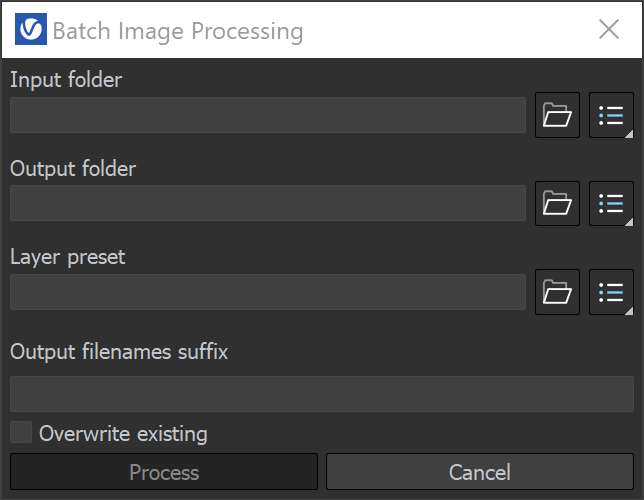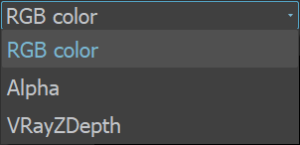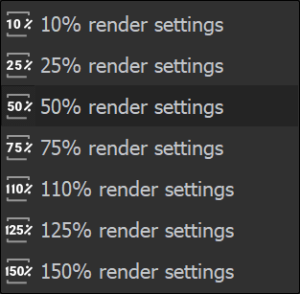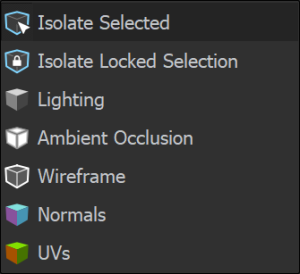Page History
...
| Section | ||||||||||||||||||||
|---|---|---|---|---|---|---|---|---|---|---|---|---|---|---|---|---|---|---|---|---|
|
| UI Expand | |||||||||||||||||
|---|---|---|---|---|---|---|---|---|---|---|---|---|---|---|---|---|---|
| |||||||||||||||||
|
...
The V-Ray Frame Buffer menu holds the main frame buffer commands. Some of the options are also available in the VFB toolbar for a quick access.
Menu | Menu Options | |
|---|---|---|
File | Save current channel – Saves the currently loaded channel to an image file format. Save all image channels to separate files – Saves all the render elements to separate files. Press the options() button to open a menu with more settings. Save all image channels to single file – Saves the image to a single multi-channel EXR or .vrimg file. Load image – Opens an image file to be previewed in the V-Ray Frame Buffer. | |
Render
Start interactive rendering – Starts IPR.
Abort rendering – Stops the current rendering.
Render – Starts rendering.
IPR Debug Shading – Enables the Debug shading/Isolate selected options in IPR. The submenu gives access to the following modes:
Isolate Selected – Renders only the selected object(s), while the rest of the scene is rendered black. You can also select material or texture nodes to isolate all objects with the assigned shader;
Isolate Locked Selection – Locks the selection to the currently selected object(s). Changes to other objects or lights can be made while rendering the same isolated object(s);
Lightning – Renders only the light contribution in the scene;
Ambient Occlusion – Renders ambient occlusion for the scene;
Wireframe – Renders the scene objects in wireframe;
Normals – Shows the normals of the scene objects;
UVs – Displays the UV coordinates of the scene objects.
Image
Follow mouse – Renders the closest bucket found to the mouse pointer, when using the bucket image sampler. If the progressive sampler is used, V-Ray samples the closest pixels to the mouse pointer.
Follow mouse – Drag the mouse over the VFB while rendering to change what part of the image is sampled first;
Follow mouse (locked) – Locks the bucket (or sampling) starting point.
Copy current channel to clipboard – Copies the current channel to the clipboard.
Duplicate to host frame buffer – Creates a 3ds Max virtual frame buffer copy of the current VFB.
Clear image – Clears the contents of the frame buffer. This is useful when starting a new render to prevent confusion with the previous image.
View
Display color space – Specifies the color space, in which the image is displayed.
None – Does not specify a color space;
sRGB – Displays the image in sRGB color space;
OCIO – Displays the image in a color space loaded from an OCIO configuration file;
ICC – Displays the image in a color space loaded from an ICC configuration file;
Gamma 2.2 – Displays the image in Gamma 2.2 color space.
Zoom VFB – Zooms in/out the rendered image in the VFB.
Zoom 50% – Zooms out to 50%;
Zoom 100% – Zooms to 100%. Alternatively, double-click in the VFB with the left mouse button;
Zoom 150% – Zooms in to 150%;
Zoom to fit – Zooms the current image to fit in the VFB. If Render Region is active – zooms to the region.
Channels – Chooses which channels to see.
View red channel – Displays the red channel;
View green channel – Displays the green channel;
View blue channel – Displays the blue channel;
Switch to alpha channel – Displays the alpha channel;
Monochromatic mode –Displays the image in monochromatic mode.
Test resolution – Enables test resolution in VFB. The submenu allows choosing a percentage of the render resolution to set as the test resolution. You can choose between 10%, 25%, 50%, 75%, 110%, 125% and 150%. Note: This only affects V-Ray and does not affect the native 3ds Max test resolution setting found under 3ds Max's Render Setup dialog.
Color clamping – Opens the color clamping submenu options:
Force color clamping – Forces color clamping;
View clamped colors – Displays the clamped colors.
Use pixel aspect – Enables visualization of the pixel aspect ratio.
Stereo – Enables stereoscopic preview. You can view the image in stereo in red/cyan or green/magenta.
Options
VFB Toolbar
Batch image processing – Allows processing of multiple .vrimg files with the same layer tree changes at the same time. |
Save VFB color corrections to render elements – When enabled, all color corrections are saved to the render channels (as opposed to only the RGB and effectsResult channels). | ||||||
Batch Image Processing Input folder – Specifies a path to start images. Output folder – Specifies a path for the output images. Layer preset – Specifies a layer tree corrections preset. Output filenames suffix – Specifies a suffix added to the output image filenames. Overwrite existing – Enables overwrite of existing files with the same name in the output folder. | |||||||
Render | Start interactive rendering – Starts IPR. Abort rendering – Stops the current rendering. Render – Starts rendering. IPR Debug Shading – Enables the Debug shading/Isolate selected options in IPR. The submenu gives access to the following modes: Isolate Selected – Renders only the selected object(s), while the rest of the scene is rendered black. You can also select material or texture nodes to isolate all objects with the assigned shader; | ||||||
Image | Follow mouse – Renders the closest bucket found to the mouse pointer, when using the bucket image sampler. If the progressive sampler is used, V-Ray samples the closest pixels to the mouse pointer. Follow mouse – Drag the mouse over the VFB while rendering to change what part of the image is sampled first; Copy current channel to clipboard – Copies the current channel to the clipboard. Duplicate to host frame buffer – Creates a 3ds Max virtual frame buffer copy of the current VFB. Clear image – Clears the contents of the frame buffer. This is useful when starting a new render to prevent confusion with the previous image. | ||||||
View | Display color space – Specifies the color space, in which the image is displayed. None – Does not specify a color space; Zoom VFB – Zooms in/out the rendered image in the VFB. Zoom 50% – Zooms out to 50%; Channels – Chooses which channels to see. View red channel – Displays the red channel; Test resolution – Enables test resolution in VFB. The submenu allows choosing a percentage of the render resolution to set as the test resolution. You can choose between 10%, 25%, 50%, 75%, 110%, 125% and 150%. Note: This only affects V-Ray and does not affect the native 3ds Max test resolution setting found under 3ds Max's Render Setup dialog. Color clamping – Opens the color clamping submenu options: Force color clamping – Forces color clamping; Use pixel aspect – Enables visualization of the pixel aspect ratio. Stereo – Enables stereoscopic preview. You can view the image in stereo in red/cyan or green/magenta. | ||||||
Options | VFB settings – Opens the VFB Settings window where you can adjusts settings for Render View, Render Region, History and Layers. | ||||||
VFB Toolbar
...
| This dropdown gives access to render elements rendered for the scene. The selected render element is displayed in the VFB. By default, the RGB color and Alpha render elements are available. Any additional render elements that have been added to the scene also appear in the drop-down. | ||
|---|---|---|
| Displays the coordinates of the mouse pointer. | ||
| Specifies the sampled area size. Click on the arrow to open a context menu with the available sampled area sizes: 1x1, 3x3, 5x5, and 7x7. | ||
Signifies whether color and display corrections are applied (RGB) or not (Raw) when showing the sampled pixel values at the current mouse pointer position. | ||
| Displays the RGB pixel values at the current mouse pointer position before applying any color corrections. | ||
Specifies RGB values. Click on the arrow to open a context menu with the available options. None – Does not specify the RGB value. | ||
| Displays the Hue, Saturation and Value of the pixel under the current mouse position when HSV is selected. | ||
| Displays the HEX of the pixel under the current mouse position when Web is selected. | ||
| Displays the 8bit color palette of the pixel under the current mouse position when 8bit is selected. | ||
| Locks the mouse pointer coordinates and displays information for the selected pixel. | ||
| Shows corrected colors. | ||
Shows the V-Ray Log which contains messages about the render process. The V-Ray Log is also available in the Log tab. | ||
| Displays the red channel. | ||
| Displays the green channel. | ||
| Displays the blue channel. | ||
| Displays the Alpha channel. | ||
Saves the image to disk. Press and hold the icon to bring up the submenu: Save current channel – Saves the current channel to an image file format; | ||
| Clears the contents of the frame buffer. This is useful when starting a new render to prevent confusion with the previous image. | ||
| Renders the closest bucket found to the mouse pointer, when using the bucket image sampler. If the progressive sampler is used, V-Ray samples the closest pixels to the mouse pointer. With this option enabled, you can right-click on the image and select Lock bucket starting point to lock the bucket (or sampling) starting point. | ||
Enables/disables test resolution in the VFB. Press and hold to bring up the submenu to select the percentage of the render resolution to set as the test resolution. Note: This only affects V-Ray and does not affect the native 3ds Max test resolution setting found under 3ds Max's Render Setup dialog.
| ||
| Allows you to render regions in the VFB. See the New V-Ray Frame Buffer section for more information. | ||
Enables the Debug shading/Isolate selected options in IPR. Press and hold to choose between the different modes: Isolate Selected – Renders only the selected object(s), while the rest of the scene is rendered black. You can also select material or texture nodes to isolate all objects with the assigned shader; | ||
| Starts IPR. If there is more than one camera in the scene, hold left mouse button to display a list of the available cameras. | ||
| Stops the current rendering. | ||
Signifies whether color and display corrections are applied (RGB) or not (Raw) when showing the sampled pixel values at the current mouse pointer position.
Specifies RGB values. Click on the arrow to open a context menu with the available options.
None – Does not specify the RGB value.
HSV – Specifies the Hue, Saturation and Value of the pixel under the current mouse position.
Web – Specifies the HEX of the pixel under the current mouse position.
8bit – Specifies the 8bit color palette of the pixel under the current mouse position.
| Locks the mouse pointer coordinates and displays information for the selected pixel. | ||
| Shows corrected colors. | ||
| Shows the V-Ray log. | ||
| Displays the red channel. | ||
| Displays the green channel. | ||
| Displays the blue channel. | ||
| Displays the Alpha channel. | ||
| Saves the image to disk. Press and hold the icon to bring up the submenu: Save current channel – Saves the current channel to an image file format; | ||
| Clears the contents of the frame buffer. This is useful when starting a new render to prevent confusion with the previous image. | ||
| Renders the closest bucket found to the mouse pointer, when using the bucket image sampler. If the progressive sampler is used, V-Ray samples the closest pixels to the mouse pointer. With this option enabled, you can right-click on the image and select Lock bucket starting point to lock the bucket (or sampling) starting point. | ||
Enables/disables test resolution in the VFB. Press and hold to bring up the submenu to select the percentage of the render resolution to set as the test resolution. Note: This only affects V-Ray and does not affect the native 3ds Max test resolution setting found under 3ds Max's Render Setup dialog.
| ||
| Allows you to render regions in the VFB. See the New V-Ray Frame Buffer section for more information. | ||
Enables the Debug shading/Isolate selected options in IPR. Press and hold to choose between the different modes: Isolate Selected – Renders only the selected object(s), while the rest of the scene is rendered black. You can also select material or texture nodes to isolate all objects with the assigned shader; | ||
| Starts IPR. If there is more than one camera in the scene, hold left mouse button to display a list of the available cameras. | ||
| Stops the current rendering. | ||
Starts rendering. If there is more than one camera in the scene, hold left mouse button to display a list of the available cameras. When pressing Shift + this button, starts Render last and the last rendered viewport/camera is rendered. | ||
| Pauses interactive rendering when using V-Ray GPU. | ||
| Refreshes interactive rendering. | ||
...
| Section | |||||||||||||||
|---|---|---|---|---|---|---|---|---|---|---|---|---|---|---|---|
|
...
The redesigned V-Ray Frame Buffer includes a suite of color corrections and tools for adjusting the image. The tools are added as layers and displayed in a layer tree. You can enable or disable a particular tool using the visibility icon () to the left of its name. The icon indicates that a layer is disabled.
For more For more information on using the Layers, see the Layers page.
...
| Section | |||||||||||||||
|---|---|---|---|---|---|---|---|---|---|---|---|---|---|---|---|
|
...
Creates a layer. Multiple layers of the same type can be added. Folder – Allows grouping multiple layers; For more information, see the Layers page. | |
| Deletes the selected layer(s). | |
| Saves a layer tree preset. | |
| Loads a layer tree preset. | |
| Quick access to custom layer presets. You must set the path to it in the VFB Settings. | |
| Undo various actions related to layers such as create, delete, reorder or modify a layer. | |
| Redo various actions related to layers such as create, delete, reorder or modify a layer. |
Each layer has a context menu. Right-click to display it:
the MultiMatte Render Element. For more information, see the Layers page. | |
| Deletes the selected layer(s). | |
| Saves a layer tree preset. | |
| Loads a layer tree preset. | |
| Quick access to custom layer presets. You must set the path to it in the VFB Settings. | |
| Undo various actions related to layers such as create, delete, reorder or modify a layer. | |
| Redo various actions related to layers such as create, delete, reorder or modify a layer. |
Each layer has a context menu. Right-click to display it:
| Section | |||||||||||||||
|---|---|---|---|---|---|---|---|---|---|---|---|---|---|---|---|
|
| Command | Description |
|---|---|
| Reset | Resets all changes done to the selected layer. |
| Save | Saves the layer as a preset. |
| Load | Loads a preset for the selected layer. |
| Delete | Deletes the selected layer. |
| Save as LUT | Bakes all the color corrections to a LUT file. |
| New Layer | Creates a new layer. |
| Duplicate | Duplicates the selected layer. |
| Blend Modes | Specifies how the selected layer blends with the result from all layers below it. |
Stats
...
The V-Ray Frame Buffer allows monitoring of different statistics and information about your scene in the Stats panel. The exact contents of the Stats changes depending on the scene, the rendering mode (interactive vs production, bucket vs progressive) and others.
| UI Text Box | ||
|---|---|---|
| ||
Right-click to display a context menu, allowing you to copy the Stats values. |
| Section | |||||||||||||||
|---|---|---|---|---|---|---|---|---|---|---|---|---|---|---|---|
| |||||||||||||||
| Section | |||||||||||||||
|
...
Log
...
The Log panel provides messages about the render process. Verbosity control is available and you can filter the type of messages shown in the Log: All, Error Only, Error & Warnings, or Error, Warnings & info. Additional options are available when you click on the Open options button:
Show progress – Shows a completion percent of each task (e.g. building Light Cache).
Wrap – Wraps longer lines in order to avoid horizontal scroll.
Undock – Docks/undocks the Log tab.
Note that the V-Ray Log is also accessible via the Show log button.
The Log tab can be detached and used as a separate window or docked elsewhere
Stats
The V-Ray Frame Buffer allows monitoring of different statistics and information about your scene in the Stats panel. The exact contents of the Stats changes depending on the scene, the rendering mode (interactive vs production, bucket vs progressive) and others.
| UI Text Box | ||
|---|---|---|
| ||
Right-click to display a context menu, allowing you to copy the Stats valuesCtr+F opens a search field at the bottom of the Log tab. |
| Section | |||||||||||||||
|---|---|---|---|---|---|---|---|---|---|---|---|---|---|---|---|
|
VFB Shortcuts
...
These shortcuts navigate through the VFB image. Please note that the VFB window must have the current focus for the shortcuts to have effect:
...
| Mouse | Description |
|---|---|
| Mouse wheel | Zoom in/Zoom out |
| Double-click left button | Zoom to 100% |
| Middle button dragging | Pan (hand tool) |
| Ctrl+Shift+Left click | Zoom in the rendered image |
| Ctrl+Shift+Right click | Zoom out the rendered image |
| Keyboard | Description |
| + / = | Zoom in |
| -/_ | Zoom out |
| * | Zoom to 100% |
| Arrow keys | Pan left, up, right, down |
| PageUp/PageDown | Switch between render elements |
| F | Fit region or whole image in the VFB |
| Esc | Abort render |
| Q | Enable history A/B vertical compare mode |
| W | Enable history A/B horizontal compare mode |
| E | Enable history A/B/C/D compare mode |
| A | View Alpha. |
| B | View Blue. |
| G | View Green. |
| R | View Red. |
| 1-9 | Load the respective image from the new VFB history |
| H | Show/hide history |
| Ctrl+L | Show/hide whole right panel |
| P | Show/hide only layers tree |
| S | Show/hide settings |
| L | Locks the mouse pointer coordinates and displays information for the selected pixel, i.e. activates the Lock pixel info coordinates button. |
| Ctrl+C | Copy the VFB image to the Windows clipboard; the image is copied exactly as it appears on the screen (meaning sRGB/LUT/OCIO etc. corrections are applied). The full resolution image is copied to the clipboard, even if the VFB view is zoomed in/out. |
| Ctr+Z | Undo various actions related to layers such as create, delete, reorder or modify a layer. |
| Ctr+Y | Redo various actions related to layers such as create, delete, reorder or modify a layer. |
| Ctr+F | Activates the Search field in Log tab. |
| UI Text Box | ||
|---|---|---|
| ||
Please, note that when the Enable shortcuts option (VFB > Options > Shortcuts tab) is disabled, all 3ds Max shortcuts are expected to have effect, even if the VFB window is in focus. |
...












